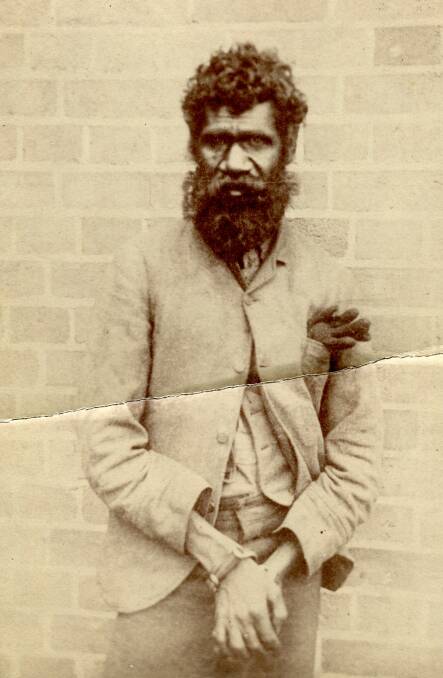
THIS week's photo, from the Bathurst District Historical Society, shows a handcuffed and bearded Jimmy Governor, a part-Aboriginal itinerant homestead worker who brutally murdered 10 people in one week in July 1900. This photo was supposedly taken at the current Bathurst jail.
Jimmy, son of bullock driver Sam Governor and his wife Annie (nee Fitzgerald), was born in 1875 beside the Talbragar River. They sent him to the nearby mission school to start his schooling.
Subscribe now for unlimited access.
$0/
(min cost $0)
or signup to continue reading
Not too interested in education, he started work on a farm before joining the police at Cassilis as a tracker for about 18 months. He then went woodcutting and wool-rolling. On December 10, 1898, he married a 16-year-old white woman, Ethel Mary Jane Page, in Gulgong in the Church of England rectory.
To support his wife, he took on an assortment of work before joining John Thomas Mawbey at Breelong in April 1900, splitting posts at 10 shillings per 100 plus rations. Others joined Jimmy and Ethel, including his brother Joe Governor and Jacky Underwood, each helping with the fencing. Later, Jimmy's nephew Peter Governor arrived.
The Mawbeys employed Ethel to help Mrs Mawbey with the housework.
Newspapers reported that there were strains in Jimmy's marriage. Ethel had argued with the Mawbeys as they were dissatisfied with her standard of housework. Another problem was that a school teacher who boarded with the Mawbeys, and Mrs Mawbey, had confronted Ethel about marrying an Aboriginal man.
Jimmy, along with Underwood, decided to confront the two women in the early evening of July 20. There were seven children in the house at the time, along with Mrs Mawbey's sister, 18-year-old Elsie Clarke.
Jimmy had a grudge against Mrs Mawbey for a few shillings she made him pay for rations. He claimed that the two women abused him, saying he wanted shooting for marrying a white woman. After hearing this, he lost all control and, with Underwood, they killed the two older women with a tomahawk with a green yarran handle and nullas. They also murdered the three Mawbey children. Some of the victims were hit three or more times. In the melee, Elsie Clarke was seriously injured.
It quickly became known as the Breelong Massacre, which was later immortalised in the fictionalised novel and film The Chant of Jimmy Blacksmith.
Jacky Underwood, aka Charlie Brown, was caught quickly and taken to Gilgandra, where he was charged with the murders at Breelong at Police Court on August 22, 1900.
Jimmy and Joe Governor, however, got away, going on a 14-week rampage in which they covered more than 2000 miles. Referring to themselves as bushrangers, the pair ran amok, frightening locals over a widespread area of northern central NSW. Every newspaper was soon covering all aspects of the escapees and the murders.
The marauding men were searching for those who had wronged them. As those who had wronged them were found, they were slain: Alexander McKay near Ulan was first on July 23 and Elizabeth O'Brien and her baby son were killed the next day near Merriwa. On July 26, Keiran Fitzpatrick lost her life near Wollar.
Despite numerous police, civilians, bloodhounds and black trackers from Queensland looking for them, Jimmy and Joe Governor managed to commit break-ins and robberies. The pair kept ahead of the pursuing lawmen as they rode to Narrabri in the north. Then they moved through the Quirindi locality, heading for the rough and rocky country that was the headwaters of the Manning and Hastings rivers.
Revelling in their ability to make it difficult for their pursuers, the Governor brothers let their whereabouts be known. As it became the largest manhunt in Australia's history, the government offered a reward of £1000 each for their capture.
Jimmy was finally shot by a hunter and wounded and was captured near Wingham on October 27. He stood trial and was hanged at Darlinghurst jail on January 18, 1901.

